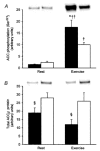Role of 5'AMP-activated protein kinase in glycogen synthase activity and glucose utilization: insights from patients with McArdle's disease
- PMID: 12068056
- PMCID: PMC2290379
- DOI: 10.1113/jphysiol.2002.018044
Role of 5'AMP-activated protein kinase in glycogen synthase activity and glucose utilization: insights from patients with McArdle's disease
Abstract
It has been suggested that 5'AMP-activated protein kinase (AMPK) is involved in the regulation of glucose and glycogen metabolism in skeletal muscle. We used patients with chronic high muscle glycogen stores and deficient glycogenolysis (McArdle's disease) as a model to address this issue. Six McArdle patients were compared with control subjects during exercise. Muscle alpha2AMPK activity increased in McArdle patients (from 1.3 +/- 0.2 to 1.9 +/- 0.2 pmol min(-1) mg(-1), P = 0.05) but not in control subjects (from 1.0 +/- 0.1 to 1.3 +/- 0.3 pmol min(-1) mg(-1)). Exercise-induced phosphorylation of the in vivo AMPK substrate acetyl CoA carboxylase (ACCbeta; Ser(221)) was higher (P < 0.01) in McArdle patients than in control subjects (18 +/- 3 vs. 10 +/- 1 arbitrary units). Exercise-induced whole-body glucose utilization was also higher in McArdle patients than in control subjects (P < 0.05). No correlation between individual AMPK or ACCbeta values and glucose utilization was observed. Glycogen synthase (GS) activity was decreased in McArdle patients from 11 +/- 1.3 to 5 +/- 1.2 % (P < 0.05) and increased in control subjects from 19 +/- 1.6 to 23 +/- 2.3 % (P < 0.05) in response to exercise. This was not associated with activity changes of GS kinase 3 or protein phosphatase 1, but the changes in GS activity could be due to changes in activity of AMPK or protein kinase A (PKA) as a negative correlation between either ACCbeta phosphorylation (Ser(221)) or plasma adrenaline and GS activity was observed. These findings suggest that GS activity is increased by glycogen breakdown and decreased by AMPK and possibly PKA activation and that the resultant GS activity depends on the relative strengths of the various stimuli. Furthermore, AMPK may be involved in the regulation of glucose utilization during exercise in humans, although the lack of correlation between individual AMPK activity or ACCbeta phosphorylation (Ser(221)) values and individual glucose utilization during exercise implies that AMPK may not be an essential regulator.
Figures





Similar articles
-
Regulation of 5'AMP-activated protein kinase activity and substrate utilization in exercising human skeletal muscle.Am J Physiol Endocrinol Metab. 2003 Apr;284(4):E813-22. doi: 10.1152/ajpendo.00436.2002. Epub 2002 Dec 17. Am J Physiol Endocrinol Metab. 2003. PMID: 12488245 Clinical Trial.
-
Decreased insulin action in skeletal muscle from patients with McArdle's disease.Am J Physiol Endocrinol Metab. 2002 Jun;282(6):E1267-75. doi: 10.1152/ajpendo.00526.2001. Am J Physiol Endocrinol Metab. 2002. PMID: 12006356
-
Regulation of glycogen synthase in skeletal muscle during exercise.Acta Physiol Scand. 2003 Aug;178(4):309-19. doi: 10.1046/j.1365-201X.2003.01165.x. Acta Physiol Scand. 2003. PMID: 12864735 Review.
-
Progressive increase in human skeletal muscle AMPKalpha2 activity and ACC phosphorylation during exercise.Am J Physiol Endocrinol Metab. 2002 Mar;282(3):E688-94. doi: 10.1152/ajpendo.00101.2001. Am J Physiol Endocrinol Metab. 2002. PMID: 11832374
-
Transgenic models--a scientific tool to understand exercise-induced metabolism: the regulatory role of AMPK (5'-AMP-activated protein kinase) in glucose transport and glycogen synthase activity in skeletal muscle.Biochem Soc Trans. 2003 Dec;31(Pt 6):1290-4. doi: 10.1042/bst0311290. Biochem Soc Trans. 2003. PMID: 14641045 Review.
Cited by
-
Glycogen shortage during fasting triggers liver-brain-adipose neurocircuitry to facilitate fat utilization.Nat Commun. 2013;4:2316. doi: 10.1038/ncomms3316. Nat Commun. 2013. PMID: 23939267 Free PMC article.
-
AMPK: energy sensor and survival mechanism in the ischemic heart.Trends Endocrinol Metab. 2015 Aug;26(8):422-9. doi: 10.1016/j.tem.2015.05.010. Epub 2015 Jul 6. Trends Endocrinol Metab. 2015. PMID: 26160707 Free PMC article. Review.
-
Preclinical Research in McArdle Disease: A Review of Research Models and Therapeutic Strategies.Genes (Basel). 2021 Dec 28;13(1):74. doi: 10.3390/genes13010074. Genes (Basel). 2021. PMID: 35052414 Free PMC article. Review.
-
Association of AMP-activated protein kinase subunits with glycogen particles as revealed in situ by immunoelectron microscopy.J Histochem Cytochem. 2009 Oct;57(10):963-71. doi: 10.1369/jhc.2009.954016. Epub 2009 Jul 6. J Histochem Cytochem. 2009. PMID: 19581628 Free PMC article.
-
Glucose Plus Fructose Ingestion for Post-Exercise Recovery-Greater than the Sum of Its Parts?Nutrients. 2017 Mar 30;9(4):344. doi: 10.3390/nu9040344. Nutrients. 2017. PMID: 28358334 Free PMC article. Review.
References
-
- Aschenbach WG, Suzuki Y, Breeden K, Prats C, Hirshman MF, Dufresne SD, Sakamoto K, Vilardo PG, Steele M, Kim JH, Jing SS, Goodyear LJ, Depaoli-Roach AA. The muscle-specific protein phosphatase PP1G/RGL (GM) is essential for activation of glycogen synthase by exercise. Journal of Biological Chemistry. 2001;276:39959–39967. - PubMed
-
- Bak JF, Pedersen O. Exercise-enhanced activation of glycogen synthase in human skeletal muscle. American Journal of Physiology. 1990;258:E957–963. - PubMed
-
- Begum N. Stimulation of protein phosphatase-1 activity by insulin in rat adipocytes. Evaluation of the role of mitogen-activated protein kinase pathway. Journal of Biological Chemistry. 1995;270:709–714. - PubMed
-
- Bergeron R, Russell RR, III, Young LH, Ren JM, Marcucci M, Lee A, Shulman GI. Effect of AMPK activation on muscle glucose metabolism in conscious rats. American Journal of Physiology. 1999;276:E938–944. - PubMed
-
- Bier DM, Leake RD, Haymond MW, Arnold KJ, Gruenke LD, Sperling MA, Kipnis DM. Measurement of ‘true’ glucose production rates in infancy and childhood with 6,6-dideuteroglucose. Diabetes. 1977;26:1016–1023. - PubMed
Publication types
MeSH terms
Substances
LinkOut - more resources
Full Text Sources
Molecular Biology Databases
Miscellaneous

